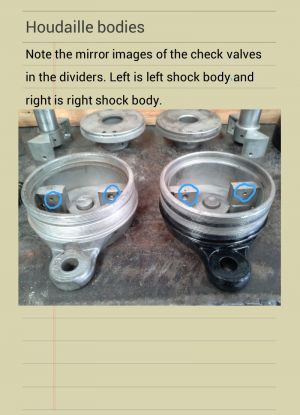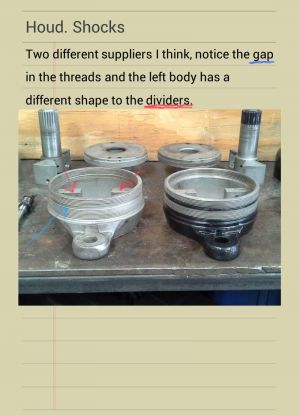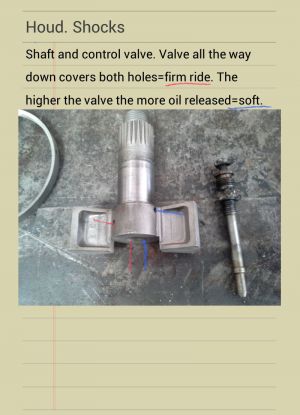- Home
- About Us
- Join/Renew
- Member Benefits
- Member Pages
- Log In
- Help
- Museum Store
Back in 2009 there was a thread of shock oil and it was mentioned to use motorcycle fork oil. What weight oil seems to work the best.
I have a 1930 B with the Houdaille shocks.
Does anybody know the shaft seal number?
I had the Houdaille shocks done back in 2006 for my 1929 by a shop in Santa Ana Calif so I don’t know what oil they used but a tiny amount leaked out and it appeared to be clear.
I inquired not too long after about doing another set myself and was told that unless you’re going to make a habit of rebuilding them it’s not worth the effort to make all the necessary jigs for just one set of shocks.
I thought I read in the original manual that mineral oil was used originally by Pierce.
I thought I had read in some paperwork that Pierce used glycerin and alcohol.
It’s more the principle. I know I can do it for not much more than 3X what I could send it out for. I made a fixture to be able to get them apart and so far they seem to be in pretty decent shape wear wise. I’ll bead blast them tomorrow for a better look. I don’t see any bushings at this stage and the shafts fit the housing with almost no play.
John Cislac said to use the fork oil but he said that it was an experiment as to the weight of oil.
6 years ago “Five Points” in the Los Angeles area rebuilt my 1930 shocks. I think there is an article in PAS repair notes discussing the subject. The lubricant used was something very common, like Glycerine. Five Points is still in buiness and can be found in PAS Parts Directory.
I would use either 5 or 10 weight motorcycle fork oil. From memory 5 was used in a lovejoy shock on my Cadillac. It isn’t very expensive, and some shocks are also adjustable. Experiment and post your results.
I was told to use, and have used hydraulic jack oil. Seems to leak out just as well as anything else.
Jim, could you post some photos of your jigs, what tools and proceedures you used to take the shocks apart, and photos of the seals you need?
I’d love to repair my own shocks. they leak pretty bad. I’ve been using ATF, since I have it in quantity, it’s a roughly 5wt hydraulic oil. And I can tell the difference between the red shock oil stains and the engine oil stains and gear oil stains..
Greg Long
I also wanted to do my own which were very tight but with flushing and soaking in alcohol until clean then working the arm back and forth, at first with cheater and caution not to break the arm until it was moving as good as I thought it should Then I fill with glycerin mixed in the ratio called for in the manual which it seems was mostly glycerin about 5 to 1 if I remember correctly. This made the shock work pretty stiff.
I am not quite ready to drive the car yet so do not know how they perform.
I would think that more alcohol would make a looser movement but I am not an engineer.
Greg,
So everybody understands I don’t claim to be an expert of anything in reguards to a PA since this is my first one and no telling who or how many times it has been molested in the past 80+ years. All I can do is deal with what I have now.
The only fixture I have made so far is a 3″X3″X1/4″ piece of angle iron bolted to a heavy steel workbench and drilled to bolt the shock body to. It holds the body securely while trying to get it apart. A 1 11/16″ box wrench from a used tool store and a cheater bar has worked so far in getting the inner plate off. The plate is under the nut, arm and round fluid reserve (with the fill plug)
I think I found seals that will work but wont know until next week. If I need to make anything else I’ll post a picture if I can’t describe it.
I think that when the glycern evaporates that is what leaves the semi-solid in the workings.
Pierce-Arrow did indeed specify a 90-10 mix of glycerine and alcohol for Houdaille shocks (I can’t speak for the Delco-Lovejoys but doubt they used glycerine). Shock rebuilders today use hydraulic oil and **seals appropriate for the fluid used.**
Because glycerine is so benign to all kinds of sealing materials, I have used the glycerine mix on Houdaille shocks that may not have been rebuilt, and jack oil on those known to have been rebuilt in recent years. I use denatured alcohol rather than isopropyl due to the water content in the latter.
I have 11 pictures with descriptions of the rear shocks disassembled and cleaned. If there is intrest on the board I will see if I can figure out how to post them. Does each picture need to be a seperate post?
If I can only post 1 picture at a time and only a couple of people are interested I can email them to you if you contact me instead of making this thread even longer.
At this time I am going to assume that the front shocks are the same inside.
Post them please. I bet most members will be interested.
Jim,
Don’t try to upload a HUGE picture. Any pictures you upload will be resized to a maximum resolution of 1024×768 pixels. Also, the picture file needs to be smaller than about 4mb…bigger than than will likely time-out before the transfer completes. If you resample your photos to 1024 x 768, the file size will likely take care of itself.
Paul
Jim,
82kb should be fine. Use JPG only (no tiff, png, etc). Sometimes blanks spaces in the filename cause problems. Remove (collapse) the blanks or substitute underscores in place of blanks.
Paul
All sounds very tech talk!! Obviously the rebuilding of the shocks is simpler!! VERY interested to access the photos. MUCH appreciated
Jim,
Why not send copies, electronic (on disk) or otherwise to Arnold Romberg and he might publish them in the PAS Service Bulletin.
Peter
I think this is going to work now. The pictures might be slightly confusing so ask if there are questions.

The check balls in these shocks freed up with carb spray, dental picks and air pressure. The springs still had tension and the ball were slightly pitted but the balls seal about 80-90% so since it looks like the only way to get them out involves a lot more work I left them. Your milage may vary.

.

.

